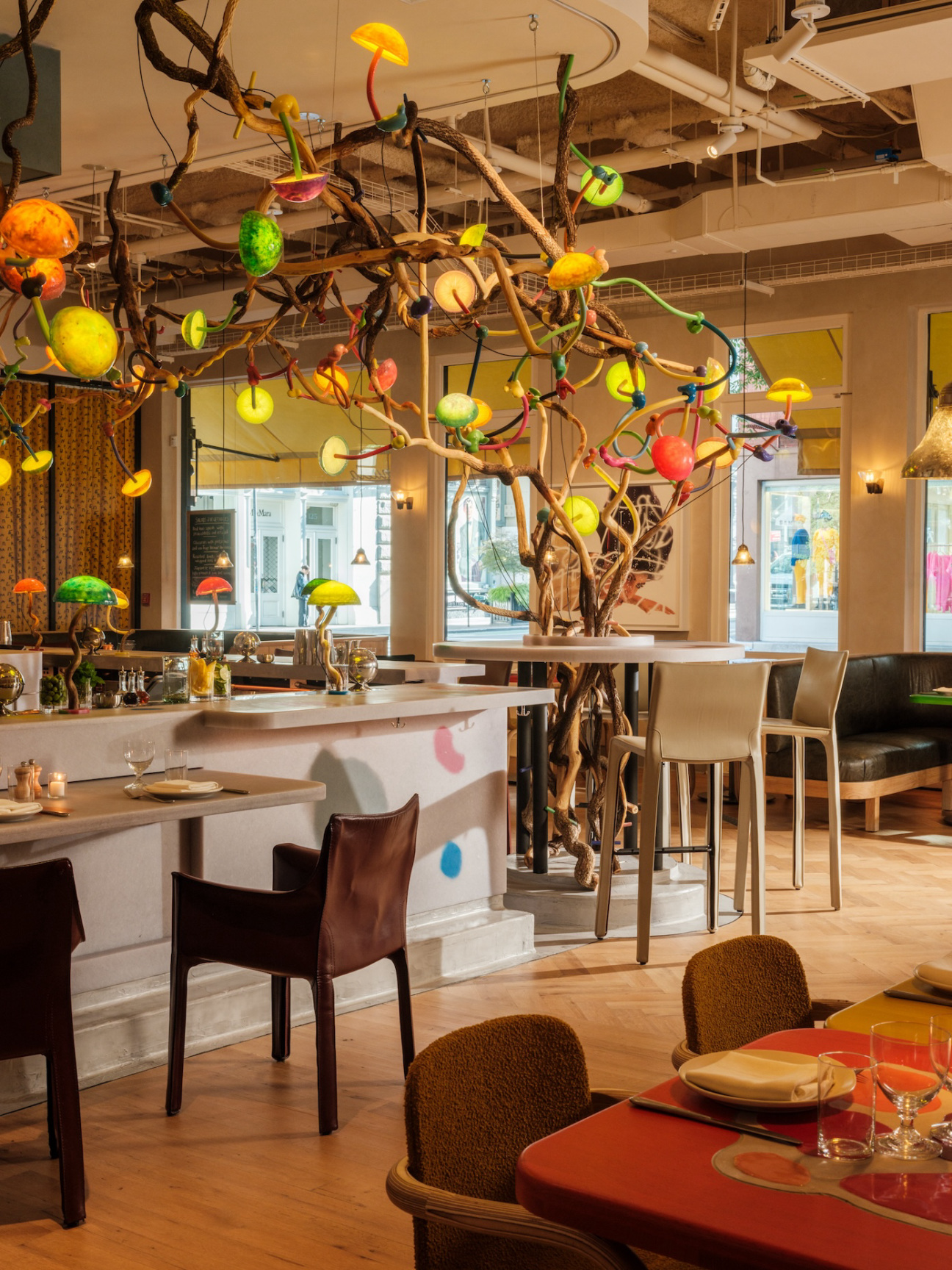
A new restaurant just opened its doors in Soho, and it's destined to stand out.
Manuela is the first New York restaurant from Artfarm, the independent hospitality and development company owned by Manuela and Iwan Wirth, the duo behind the mega-gallery Hauser & Wirth. (Artfarm operates restaurants in Los Angeles and London, not far from Hauser & Wirth's galleries, among other locations.) Each new project is accompanied by a deep investment into sustainability (Manuela has a whole room dedicated to its composter!) and the local agricultural ecosystem.
Artfarm takes the same homegrown approach toward art as it does toward food. Hauser & Wirth's stable is well represented in the blue-chip collection that adorns the restaurant's walls. Artist Mika Rottenberg worked with nearly 100 collaborators to design a functioning bar made from a (literal) ton of recycled plastic. The tables are courtesy Mary Heilmann; the chairs are by Matthew Day Jackson. Somalian-born painter Uman, who made a mural for the restaurant, described the process of creating a site-specific work for Manuela as a "joy," further bolstered when contractors gave her compliments during its installation. "A mural in a restaurant is for everyone, from the patrons to the staff to the owners," she told CULTURED. "'Manuela no. 1' belongs there, surrounded by art, flowers, people—on a path where it will be seen by all, upstairs and downstairs.”
To mark its debut, Ben Crofton, Artfarm's U.S. operations director, and Bee Emmott, the company's creative director, sat down with CULTURED to talk about the journey behind opening a neighborhood institution—and the unique ethos that's brought it to life.
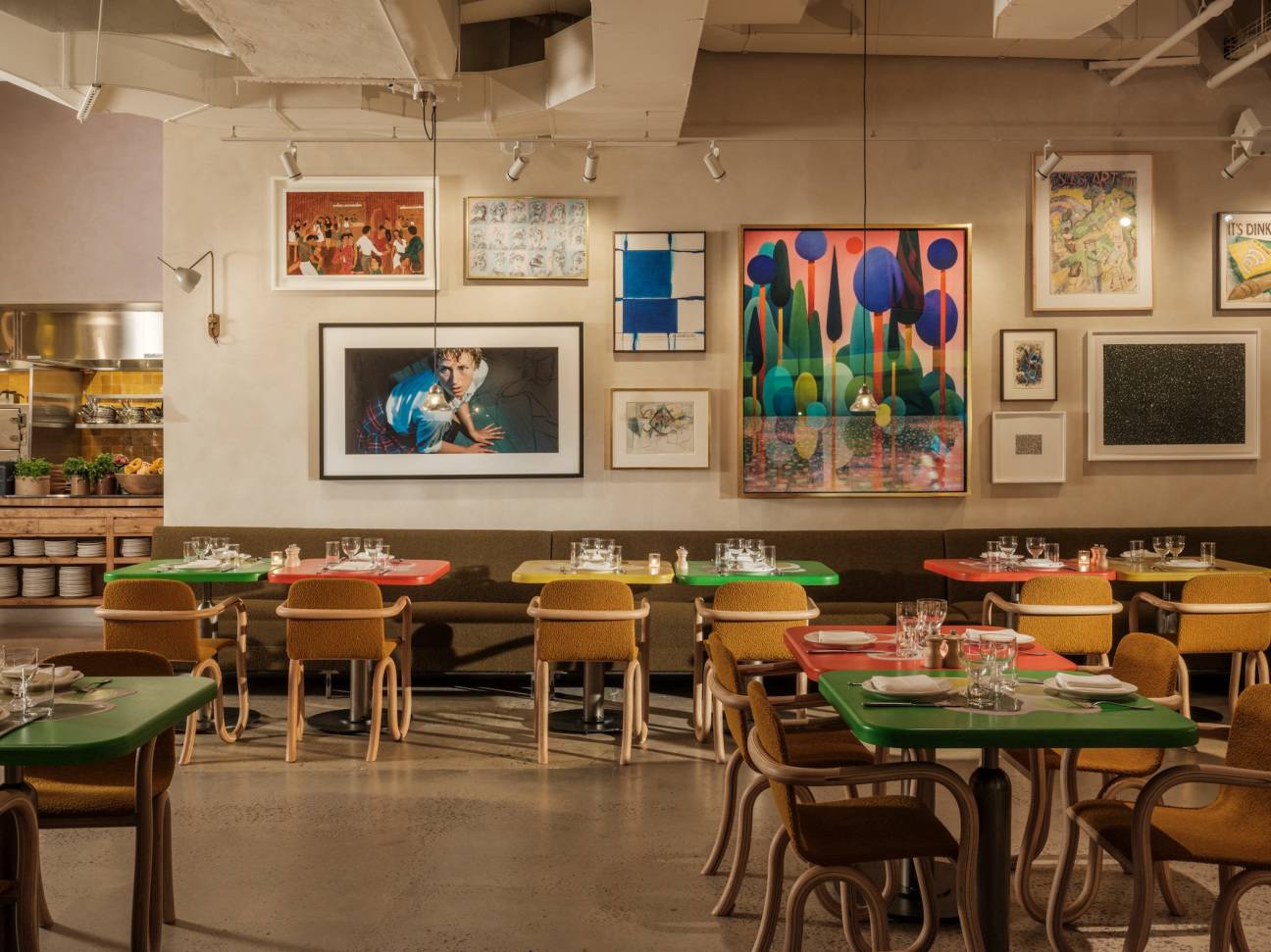
Where are you, and what’s in your system?
Ben Crofton: We’re at Manuela, and I've had a black coffee.
Bee Emmott: I’ve had a skinny cappuccino. I did order breakfast where I'm staying, but I wasn't hungry. Probably because I ate here last night and had so much delicious food.
What brought both of you to Artfarm?
Crofton: I lived in Somerset, where the original Artfarm was created. I was very aware of Iwan and Manuela [Wirth] and Artfarm. We had our own restaurant in Somerset for a few years, and through conversation [with them] I decided to assist with this project out here—commuting from Somerset to New York. As the project grew, I decided to relocate out here with my family.
Emmott: My background is in the arts, so I also knew about Iwan and Manuela Wirth. And then they were working on this incredible project in Scotland, and at the time that was our hotel, The Fife Arms. So I ended up meeting them and eventually started working with them.

How have you seen Artfarm evolve over the years, and what’s kept you here?
Crofton: My background was in pretty formal restaurants—I ran restaurants here in the U.S and in the U.K. There's something very special about this business, and it stems from Iwan and Manuela and their approach to hospitality. It's not a commercial business in the sense that the way they pick properties could be through an emotional attachment to a property or to a building. It's a very organic approach to growth, and I like that very much.
Emmott: They have such a strong vision. These properties almost find them. And we root every single project in this deep research of a place’s context. That's why none of our projects look or feel the same. They all are very particular to that exact place that they're born. And not coming from a background of hospitality, it’s incredible how they see art and food as this sort of catalyst for incredible connection and conversation. When you look at any of our projects, there's art everywhere, but it's not about whether you know the art or not. You could come in with absolutely zero understanding that there's a George Condo on the wall. There's this very democratic approach—you are here to enjoy food and drink and have an amazing time in this incredible place. That’s the fundamentals.
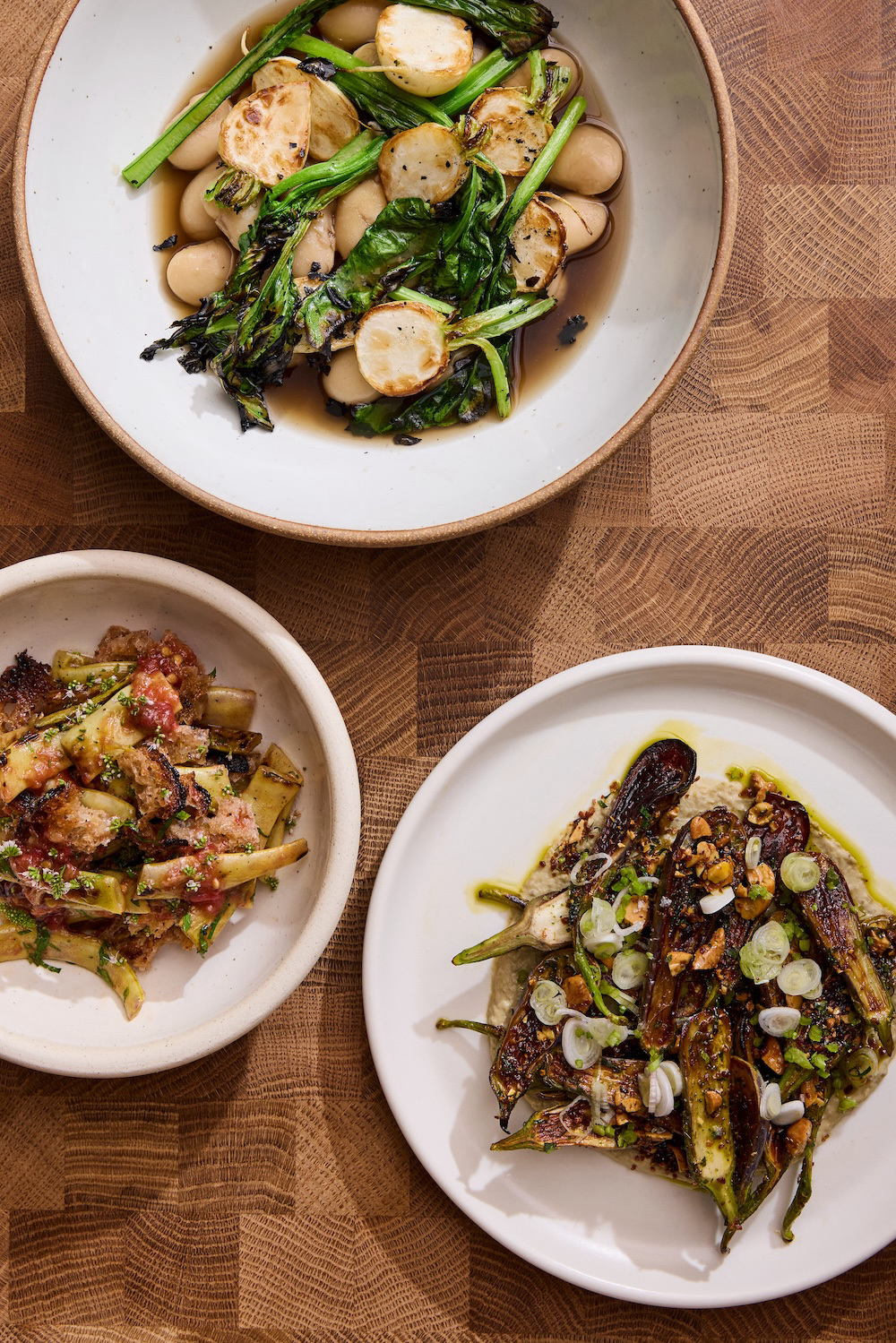
This is not the first Manuela—the original opened in Los Angeles eight years ago. What has it been like to bring the concept to New York?
Emmott: A lot of it is rooted in the food and our approach to sourcing it—the network of farmers and growers and makers we work with. That’s the golden thread between the two properties. The design is quite different. Here, it’s very rooted in the fact that we're in the middle of Soho, which has a particularly rich artistic history.
Crofton: The Manuela restaurant is obviously named after Manuela Wirth, who is a very warm and hospitable person. And that's what Manuela represents. It's like this home for artists. And the LA location has a relaxing, rustic outdoor feel to it. The menu is all about provenance. It's about locality, acidity, fruit, and a fresh, vibrant feel. But we were very aware that coming to New York, it had to have its own identity. I was slightly apprehensive in not knowing what I was gonna be exposed to in terms of suppliers and product, but I was pleasantly surprised when we started to do the research and found so many wonderful, diverse growers and farmers that were on the East Coast, specifically in New York state. The menu grew from that. It’s about 50% vegetables. We wanted to emphasize the local growers and farmers we visited, who nurtured the products that shaped this vegetable-heavy menu. So the proteins are almost like side dishes, with the vegetables at the pedestal for the restaurant. And the seasonality here is so special. In California, you can get everything almost year-round. Here, there’s a real celebration for certain ingredients that are only in season for a short period of time.
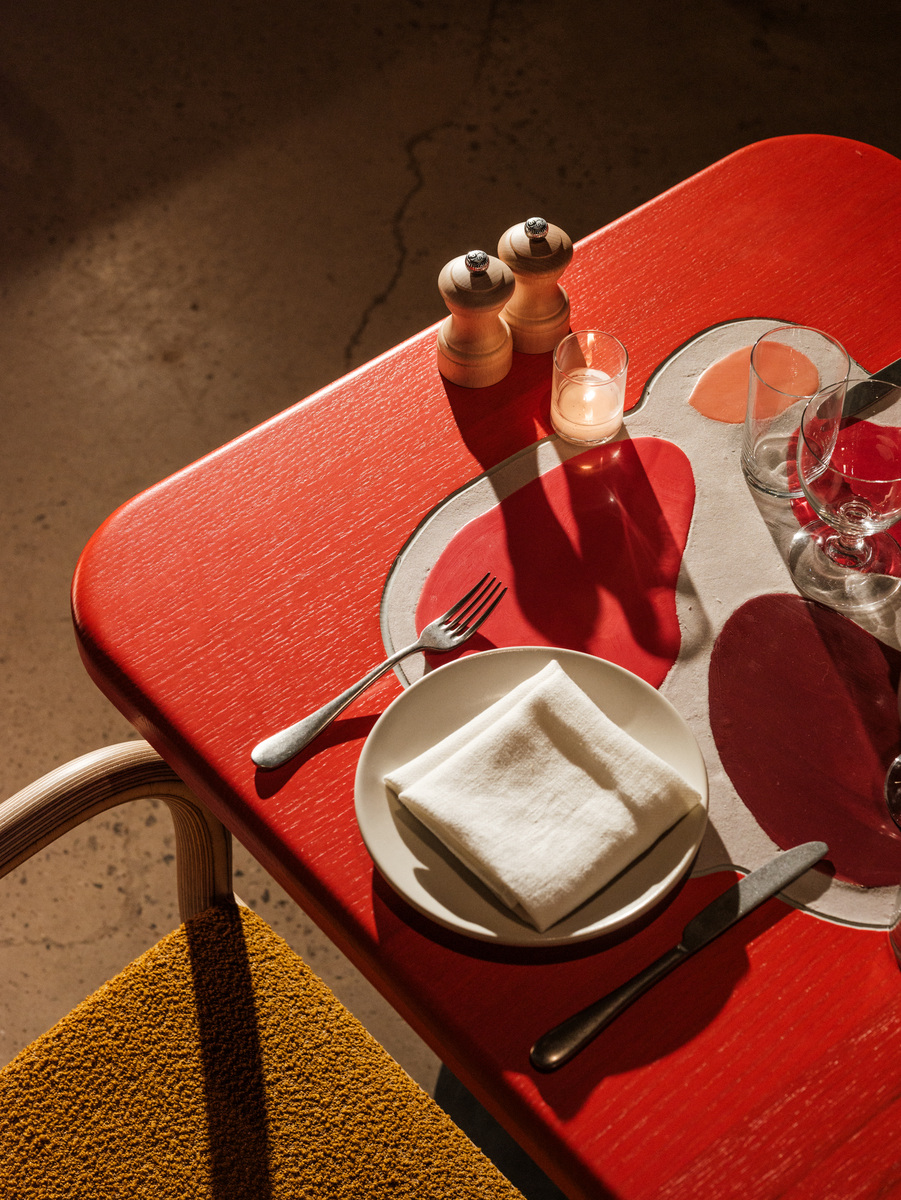
How did the conversations with the artists who made works for Manuela start? And what do you think the hospitality context brings out of these works?
Emmott: When we started this project, we knew we wanted to work with artists who had a connection to New York or Soho. The way we collaborate with our artists is deeply personal: Iwan and Manela have close relationships with each of them. When we approach any artist, we’re asking them to do something likely outside of their usual practice. These site-specific, living artworks are a real challenge for everyone to create. For example, Mika Rottenberg’s bar was an absolute feat that involved about a hundred collaborators to make it a functioning bar that can handle the hundreds of martinis we serve every night.
Crofton: And there’s the fact that it's made out of discarded plastic and Japanese knotweed!
Emmott: There's over a ton of plastic in there, some of which comes from the plastic waste of our own projects. That idea of closing the circle—embracing sustainability and that journey—is really important. I think the artists thrive off that challenge, even though it’s tough. They love being pushed to such extremes, and their work reaches such a different audience. People who walk in here don’t need to know who the artists are—they're still interacting with the tables and touching them. But you really notice it when people come in; they touch the table differently, put their glass down differently, and even experience their food differently. I sat at the bar last night, and the way you interact with the bar is just unlike any other. What's quite special about artwork in this environment is how it’s translated into a functional, living object that will naturally change and evolve. That just creates a different human connection with the artwork, unlike seeing it in a gallery context.
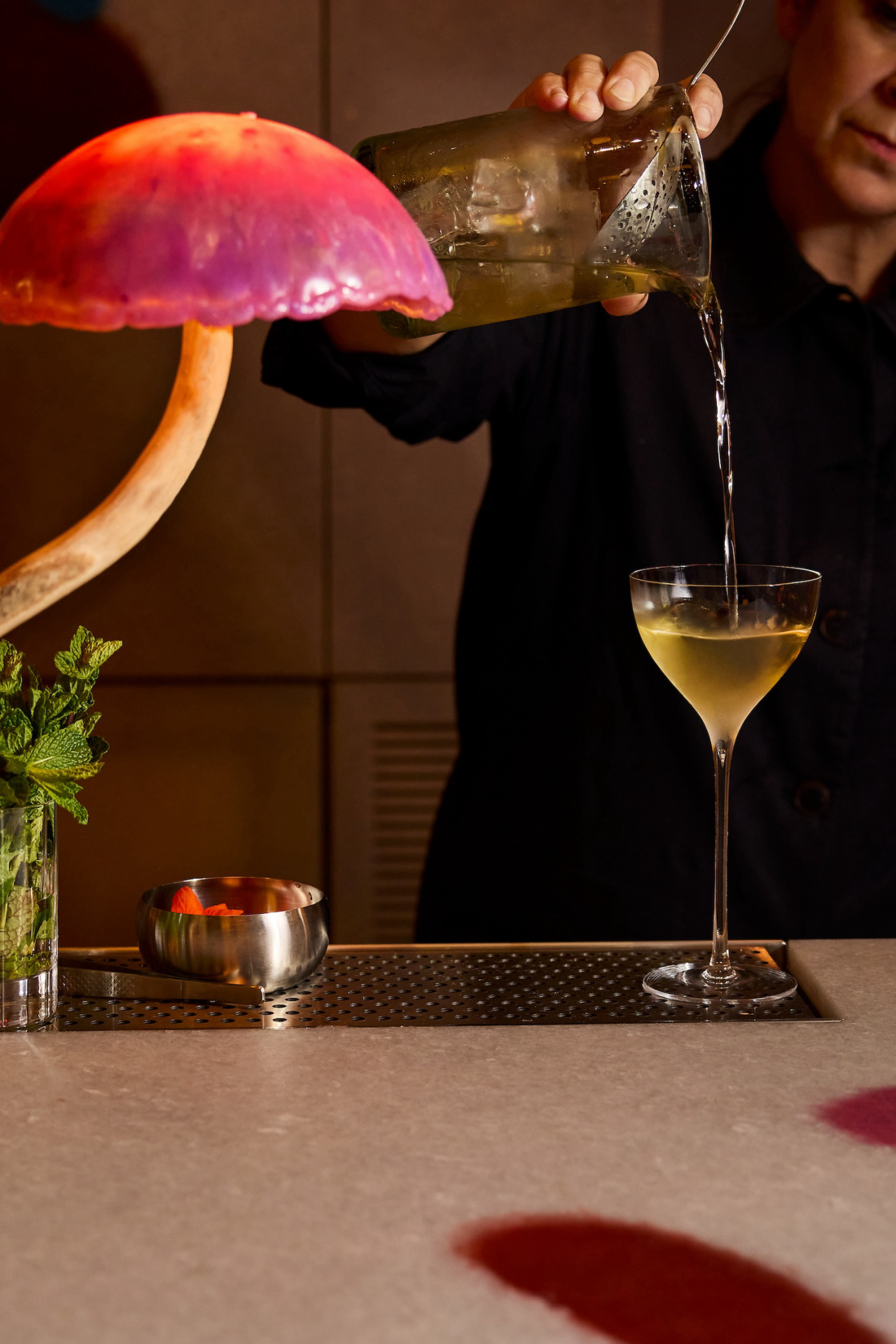
In the spirit of camaraderie, and knowing that you're here quite often now, what are some other local restaurants that are in your regular rotation?
Crofton: I’ve found that I like restaurants that have a distinct neighborhood feel—places that feel specific, but also have a warmth to them. Like Roscioli, this very small Italian restaurant with just a handful of tables. That’s the kind of place I’d want to eat at if I lived in Soho. I also love restaurants like King or Chambers, where the menu is incredibly small, but everything you eat feels really connected to the season. There aren’t many restaurants like that—so much of the food in New York feels heavy, so this vegetable-forward style of cooking is special.
Emmott: More so than in the U.K., I’d say people here are deeply loyal to their regular spots and neighborhood cultures. When we were thinking about Manuela, we knew we were going to be quite different—that we would stand out. But we wanted to capture the feeling and spirit of those neighborhood restaurants, while recognizing that we're working on a different scale with about 150 covers.
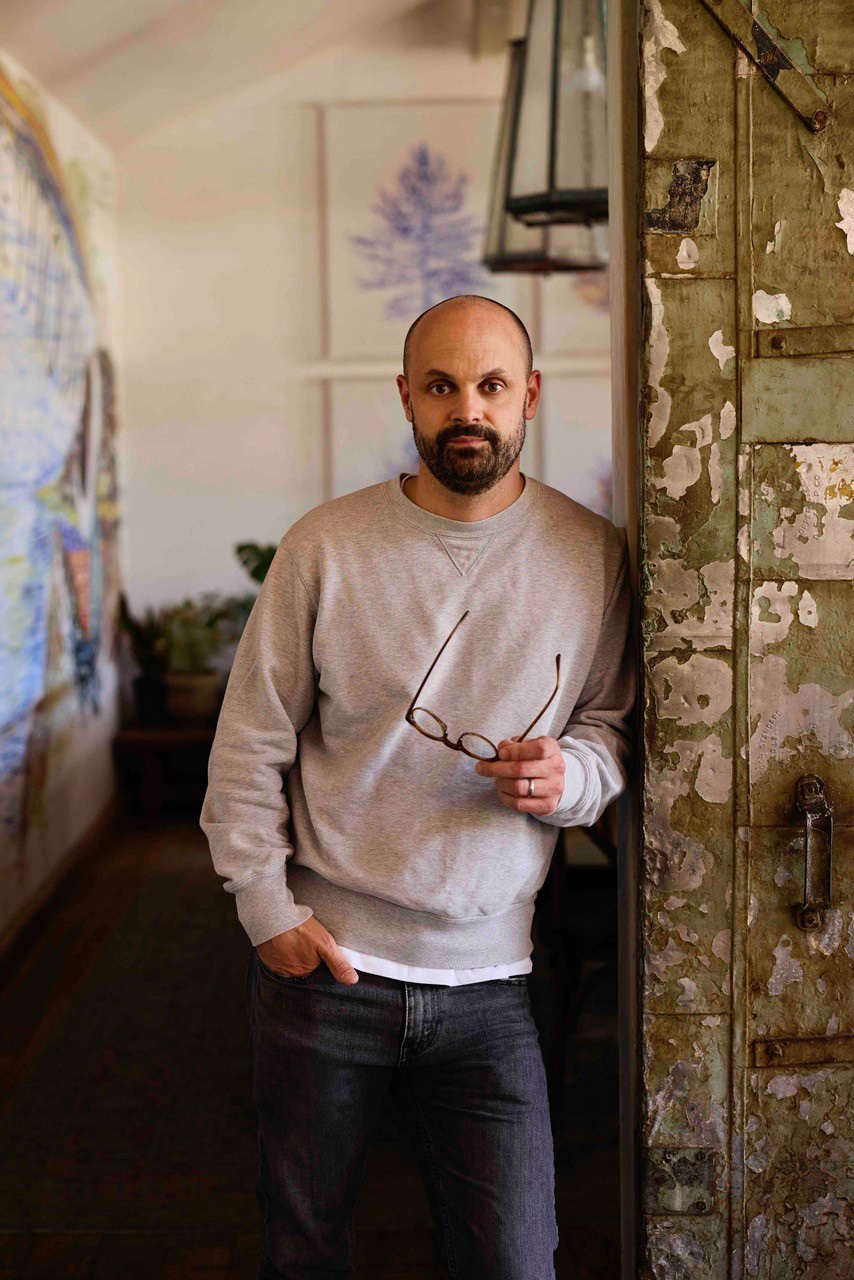
If you were to host a dinner party here with some of your artistic and culinary idols, who would your first invites go to?
Emmott: To be honest, it would be very fascinating to get the artists whose work is on view here together and just be a fly on the wall.
Crofton: More than chefs, I’d be excited about filling the space with farmers and growers, along with artists. That mix could be really fun.
And what’s a dish from the menu that best describes where you are at in your lives right now?
Crofton: Recently, there was this really deep, caramelized onion broth—very simple but packed with flavor. I can't remember if they were Roscoff onions or something else, but they added beans and brassicas. It felt very autumnal. It was light, healthy, and comforting—exactly what I want as the weather changes.
Emmott: We’re in this exciting phase of the opening. It feels like a bit of a relief in a way—for the team to finally be doing what they’ve been preparing for. If I were to translate that feeling into a dish on the menu, it would be the Concord grape sorbet. There's a simplicity and freshness to it, like a new start.










 in your life?
in your life?

